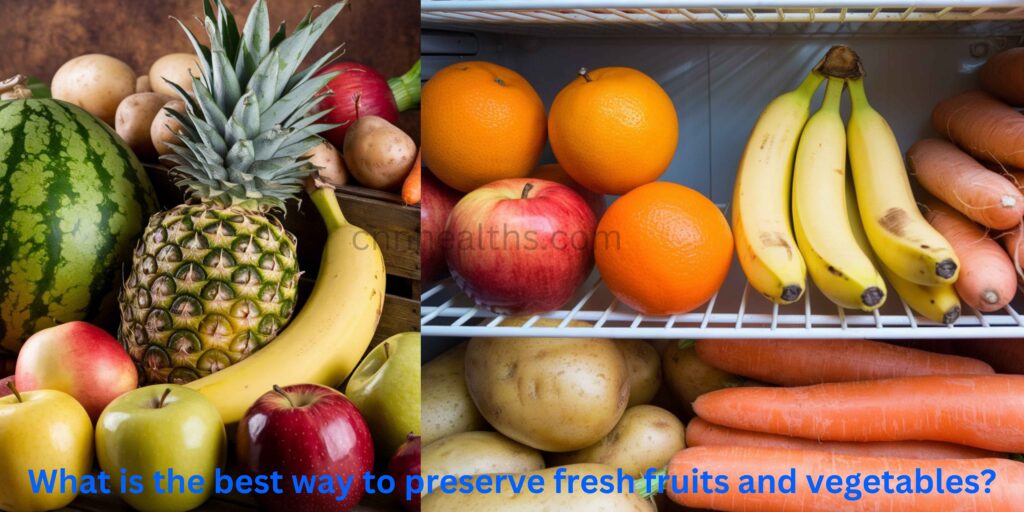What is the best way to preserve fresh fruits and vegetables?
Intro
Fresh fruits and vegetables are not only delicious but also packed with essential nutrients that contribute to our overall health. However, the challenge often lies in keeping them fresh for as long as possible. If you’ve ever found yourself tossing out wilted greens or overripe fruit, you’re not alone. Understanding the best way to preserve fresh fruits and vegetables can help you minimize waste and enjoy your produce at its peak flavor and freshness. From simple techniques like proper storage methods to more advanced options such as canning and freezing, there are a variety of strategies to choose from. This blog post will explore these options and provide practical tips to help you extend the life of your fruits and veggies, ensuring that you can savor their taste and health benefits for days or even weeks to come. Let’s dive into the world of preservation and discover how you can keep your produce thriving!

Understanding the Importance of Fresh Produce Preservation
Preserving fresh fruits and vegetables is more than just a matter of convenience; it’s an essential practice that impacts our health, finances, and the environment. When we extend the shelf life of our produce, we maximize the nutritional benefits they offer, ensuring we get the most out of our diet. Moreover, proper preservation techniques help reduce food waste, which in turn can save money and lessen our environmental footprint. According to studies, a significant portion of the produce we buy ends up in the trash due to spoilage. By understanding the best way to preserve fresh fruits and vegetables, we can play a part in combating this issue. Proper preservation not only retains the flavor and texture of the produce but also maintains its essential vitamins and minerals. Techniques like refrigeration, canning, and freezing, along with the right packaging, can significantly extend the life of your fruits and vegetables, allowing you to enjoy them over a more extended period. In essence, learning these preservation methods is a small effort that yields substantial rewards for both you and the planet.
Proper Storage Techniques for Different Types of Produce
Different types of fruits and vegetables require unique storage methods to maintain their freshness. For instance, leafy greens like spinach and lettuce thrive when wrapped in a damp paper towel and stored in a perforated plastic bag in the crisper drawer of your refrigerator. Root vegetables such as carrots and beets should be kept in a cool, dark place, ideally in a breathable bag to prevent moisture buildup. Fruits like apples and pears can be stored in the fridge but should be kept away from vegetables to prevent them from accelerating ripening and spoilage due to ethylene gas. Bananas and avocados, on the other hand, prefer room temperature until they ripen. Once ripe, you can refrigerate them to extend their freshness. Tomatoes should be kept on the countertop, as refrigeration can alter their texture and flavor. Berries need to be stored in the fridge, unwashed, in a breathable container lined with paper towels to absorb excess moisture. By tailoring your storage techniques to the specific needs of each type of produce, you can significantly extend their shelf life and enjoy their full flavors and nutritional benefits.
The Role of Packaging in Preserving Freshness
Packaging plays a crucial role in maintaining the freshness of your fruits and vegetables. The right packaging can help regulate moisture, control ethylene gas, and prevent damage during storage. For example, using perforated plastic bags for leafy greens allows for adequate air circulation, reducing the risk of wilting. On the other hand, vacuum-sealed bags are excellent for preserving the freshness of more robust vegetables like bell peppers and green beans by minimizing air exposure. Mason jars can be a great option for storing cut fruits, as they create an airtight environment that helps retain moisture and flavor. For berries, breathable containers lined with paper towels can absorb excess moisture and prevent mold growth. Reusable silicone bags are also a versatile choice for various types of produce, offering a sustainable alternative to single-use plastics. By selecting the appropriate packaging, you not only extend the shelf life of your produce but also maintain its nutritional quality and taste.
Freezing Fruits and Vegetables for Long-Term Storage
Freezing is a fantastic way to preserve the freshness of fruits and vegetables for months, ensuring you have access to your favorite produce year-round. The process is straightforward and retains much of the produce’s nutritional value. Begin by washing and cutting the fruits and vegetables into manageable pieces. For many vegetables, blanching—briefly boiling them and then plunging them into ice water—can help preserve color, texture, and nutrients. Fruits, like berries or sliced peaches, can be spread out on a baking sheet and pre-frozen to prevent clumping before transferring them to freezer bags or containers. Use airtight packaging to minimize freezer burn and maintain quality. Label your packages with the date to keep track of storage times, as most frozen produce is best used within 8-12 months. Remember to squeeze out as much air as possible from the freezer bags to ensure optimal freshness. Whether you’re freezing garden surplus or stocking up from the farmer’s market, this method provides a convenient way to enjoy fruits and vegetables long after their peak season.
The Benefits of Blanching Before Freezing
Blanching is a crucial step when freezing vegetables, offering several benefits that enhance the quality of your preserved produce. This quick process involves boiling vegetables briefly and then plunging them into ice water to halt the cooking. Blanching helps preserve the vibrant color, texture, and nutritional value of vegetables, preventing the enzymatic actions that can cause loss of flavor, color, and nutrients during freezing. It also helps to remove surface dirt and organisms, further ensuring the longevity and safety of your frozen veggies. For example, green beans and broccoli retain their bright green hue and crisp texture when blanched before freezing. This step also makes vegetables easier to pack, as they become more pliable and compact. While blanching might seem like an extra effort, it significantly enhances the quality of your frozen produce, making it well worth the time spent. By incorporating blanching into your freezing routine, you can enjoy garden-fresh flavors and textures long after the harvest season has ended.
Using Pickling and Fermentation to Preserve Produce
Pickling and fermentation are time-honored methods for preserving fruits and vegetables that not only extend their shelf life but also add unique flavors and beneficial probiotics. Pickling involves immersing produce in a solution of vinegar, water, salt, and sometimes sugar or spices. This acidic environment prevents the growth of spoilage organisms, allowing you to enjoy tangy delights like pickled cucumbers, onions, or carrots for months. Fermentation, on the other hand, relies on natural bacteria to convert sugars in the produce into lactic acid. This process creates a naturally preserved food with complex flavors and health benefits. Classic examples include sauerkraut, kimchi, and fermented pickles. Both methods require clean, airtight containers to prevent contamination. Ensure your produce is fresh and washed before starting the process. Fermented foods should be kept in a cool, dark place during fermentation and then stored in the refrigerator. Pickled items, once sealed in jars, can be kept in a pantry until opened. Experimenting with different spices, herbs, and produce combinations can make pickling and fermentation not only a preservation technique but also a fun culinary adventure.
Drying and Dehydrating Fruits and Vegetables
Drying and dehydrating are excellent methods to preserve fruits and vegetables, locking in their flavors and nutrients while significantly extending their shelf life. These techniques involve removing moisture from the produce, which inhibits the growth of bacteria and mold. You can dry fruits and vegetables using a food dehydrator, an oven set to a low temperature, or even air drying in a warm, dry climate. For best results, slice fruits and vegetables into uniform pieces to ensure even drying. Apples, bananas, and berries are popular choices for dehydration, offering delicious, portable snacks. Vegetables like tomatoes, bell peppers, and mushrooms also dry well and can be rehydrated for soups and stews or enjoyed as crunchy snacks. Using airtight containers or vacuum-sealed bags for storage can help maintain the quality of your dried produce. Whether you’re making fruit leathers or drying herbs, these methods provide a convenient way to enjoy your favorite fruits and vegetables well beyond their growing season.
Tips for Monitoring and Managing Stored Produce
To ensure your fruits and vegetables stay fresh for as long as possible, it’s essential to regularly monitor and manage your stored produce. Start by checking your produce at least once a week for any signs of spoilage, such as mold, discoloration, or soft spots. Removing any compromised items immediately can prevent them from affecting other stored produce. Organize your storage areas so that older items are easily accessible and used first, following the “first in, first out” principle. This helps ensure nothing gets forgotten and goes to waste.
Maintain an inventory list, noting the purchase date and expected shelf life of each item. This can be as simple as a notepad on your fridge or a digital list on your phone. Pay attention to temperature and humidity levels in your storage spaces, as these factors can greatly impact the longevity of your produce. Adjust your refrigerator’s settings as needed to create the optimal environment for different types of fruits and vegetables. Lastly, rotate your stock regularly, giving a gentle toss to items like berries to promote even airflow and prevent moisture buildup. By staying vigilant and organized, you can maximize the freshness and flavor of your stored produce.

